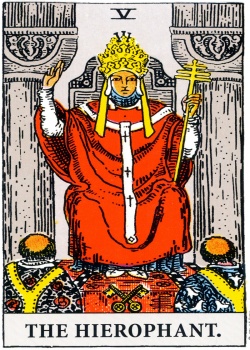Hierophant: Difference between revisions
An Avatar.Global Resource
No edit summary |
|||
| Line 13: | Line 13: | ||
===[[Book of Power]]=== | ===[[Book of Power]]=== | ||
The Hierophant is the "revealer of mysteries." <ref>Case, Paul Foster. An Introduction to the Study of the Tarot. New York: Kindle Edition, 1920.</ref> | |||
An authority figure who teachers the worthy aspirant: "(The Pope, the supreme holder of the knowledge of the Initiated.) Without complete theoretical instruction no one can tackle the effective practice of the 'Royal Art'. To pass a 'Brother' one must be practised in the handling of tools and be ignorant of nothing in the rules of architecture. The 'workman' who has reached the light perceives the Brilliant Star and knows the significance of the letter G, for geometry must be familiar to him." <ref>Oswald Wirth, Tarot of the Magicians: The Occult Symbols of the Major Arcana That Inspired Modern Tarot (San Francisco. CA: Weiser Books, 1990). p. 170.</ref> | |||
"The same idea of Esoterism, of secret Instruction, reappears; but the Tuition is now practical and oral, it no longer requires a book (third idea)."<ref>Papus, The Tarot of the Bohemians (Wilshire Book Co, 1978), https://sacred-texts.com/tarot/tob/index.htm.</ref> | "The same idea of Esoterism, of secret Instruction, reappears; but the Tuition is now practical and oral, it no longer requires a book (third idea)."<ref>Papus, The Tarot of the Bohemians (Wilshire Book Co, 1978), https://sacred-texts.com/tarot/tob/index.htm.</ref> | ||
Revision as of 12:56, 8 July 2020
Hierophant
The Hierohant is an Old Energy Archetype from the Masonic Tarot Deck. In the Book of Slavery, the archetype is typically used to reinforce elitism, and the idea that the secrets of power can only be shown to those properly formed through initiation.

List of Old Energy Archetypes from the Masonic Tarot
Chariot, Death (archetype), Duality, Hermit, Hierophant, High Priestess, Judgement, Justice, Star, Strength, Sun (archetype), Temperance, The Devil, The Emperor, The Empress, The Fool, The Hanged Man, The Lovers, The Magician, The Moon, The Tower, The Wheel of Fortune, The World (old energy)
Notes
Book of Power
The Hierophant is the "revealer of mysteries." [1]
An authority figure who teachers the worthy aspirant: "(The Pope, the supreme holder of the knowledge of the Initiated.) Without complete theoretical instruction no one can tackle the effective practice of the 'Royal Art'. To pass a 'Brother' one must be practised in the handling of tools and be ignorant of nothing in the rules of architecture. The 'workman' who has reached the light perceives the Brilliant Star and knows the significance of the letter G, for geometry must be familiar to him." [2]
"The same idea of Esoterism, of secret Instruction, reappears; but the Tuition is now practical and oral, it no longer requires a book (third idea)."[3]
"Waite describes his card as symbolizing the 'outer way' of churches and dogma. But his use of the mystery term suggests another interpretation, one more favoured by those who see the Tarot as a secret doctrine of occult practices rather than a more general embodiment of human patterns. This interpretation is dramatically portrayed in the picture of the Hierophant from Aleister Crowley's Book of Thoth, drawn by Frieda Harris. Here the trump signifies initiation into a secret doctrine, "[4]
Book of Slavery
Submit and follow the spiritual authorities. This is obvious from the symbolism of the cards, and the submission of two figures at the foot of the authority figure. This is echoed in Pollack, who seems to miss the obvious symbolism of submission.
Recovery
Pollack speaks of initiation as a means towards union." [5]
Citation and Legal
Treat the SpiritWiki as an open-access online monograph or structured textbook. You may freely use information in the SpiritWiki; however, attribution, citation, and/or direct linking are ethically required.
Footnotes
- ↑ Case, Paul Foster. An Introduction to the Study of the Tarot. New York: Kindle Edition, 1920.
- ↑ Oswald Wirth, Tarot of the Magicians: The Occult Symbols of the Major Arcana That Inspired Modern Tarot (San Francisco. CA: Weiser Books, 1990). p. 170.
- ↑ Papus, The Tarot of the Bohemians (Wilshire Book Co, 1978), https://sacred-texts.com/tarot/tob/index.htm.
- ↑ Pollack, Rachel. Seventy-Eight Degrees of Wisdom. Harper Collins, 1980. p. 53.
- ↑ Pollack, Rachel. Seventy-Eight Degrees of Wisdom. Harper Collins, 1980. p. 53.
